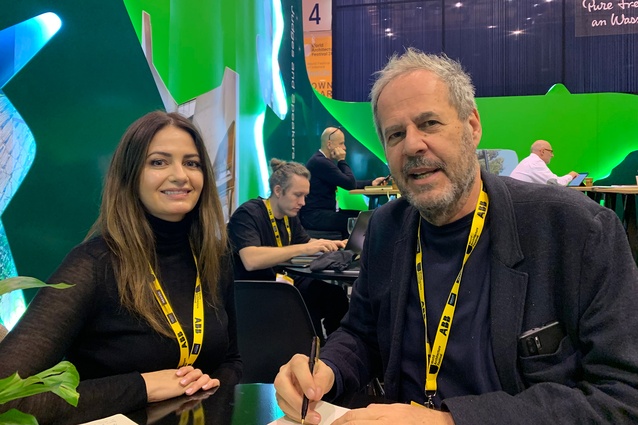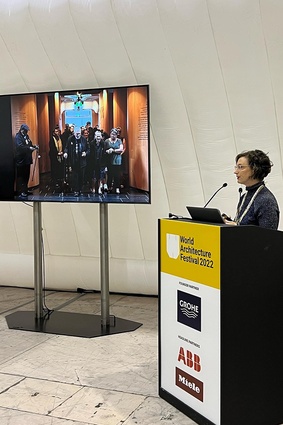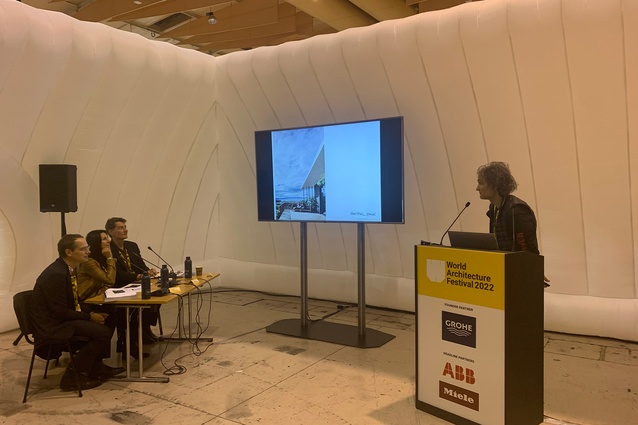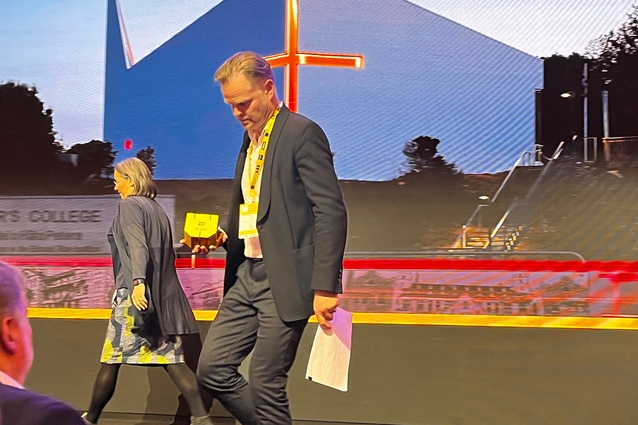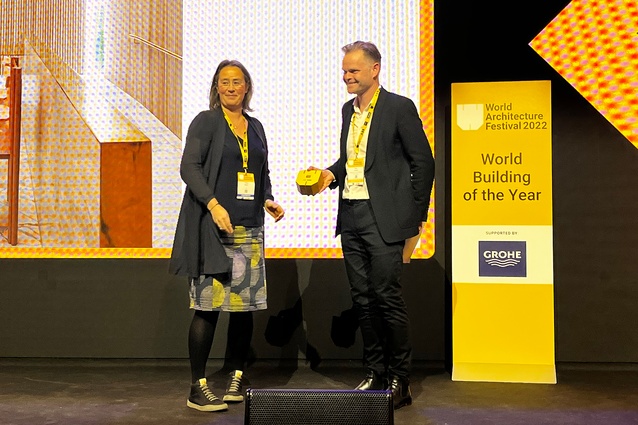WAF: An architectural navigation to re-connect
Various preparatory milestones must eventuate for participation in any worthwhile awards programme: an admirable commission, smooth consultation and construction processes, viable completion dates, heroic photography — all of which predetermines only the possibility of being shortlisted.
Following two years of Covid-enforced online-only participation, the architecture celebrated in Lisbon at the 2022 World Architecture Festival (WAF) seemed intent on finding relationships with people somewhat inadvertently reflecting the theme of ‘Together’. This was an opposing reference to the impact of isolation, and the dislocation and loneliness the architectural community (amongst others), faced during the Covid pandemic.
According to WAF and Inside programme director Paul Finch (Inside WAF’s awards programme focussing on interiors), one of the biggest challenges that architects face is in a post-pandemic world where remote work is encouraged: “Architects uniquely realise that isolation is detrimental to the collaborative exchange that occurs face to face in the studio which is required for good design.”
Since its inaugural beginnings in 2008, WAF is now recognised as one of the world’s best architectural conferences and awards programmes. Hosted in different countries, each festival tends to carry a life of its own reflecting the spirit of the city in which it is located. But it is the unique live presentations of the projects of this event that create a compelling environment for a truly global architectural attraction.
“Architects uniquely realise that isolation is detrimental to the collaborative exchange that occurs face to face in the studio which is required for good design.”
-Paul Finch WAF and Inside programme director
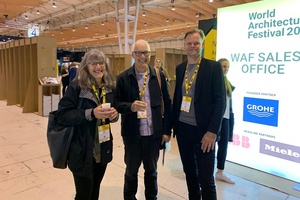
Peripherally located 11 kms from the central old town and CBD of the city, the event was held in one of four halls located within the 1998 world expo centre. The scale appeared initially underwhelming but was offset by some delightful sculptural moments found nearby like the impossibly thin catenary shells of Álvaro Siza’s Expo ’98 Portuguese National Pavilion, or the organic parasols of Calatrava’s Oriente transport interchange. Over 1500 attendees enjoyed lectures, keynote presentations from world-renowned architects, and navigated a multitude of presentation tent rooms within the main hall where the ambient sounds of the delegates and presentations simultaneously filtered towards the central circulation.
The annual festival offers architects a stimulating environment for critique on projects for peers they probably don’t know, from unfamiliar geographies. Good architects (and shortlisting almost certainly suggests competitors are good) are rarely thin-skinned about comments or criticisms – the capacity to listen and absorb is noticeable. Critical lines of thinking can be compared and contrasted, offering the chance to learn from the work of others and address similar design challenges from diverse clients and communities, all in one place.
The intellectual, cultural, and technical approaches brought to any brief may spur familiar responses to shared challenges; and watching what is in effect a competitive pitch is an education in itself. Yet for Finch, the essence of the festival is best captured as a constructive appraisal: “Nobody is competing for a job, which would give a quite different atmosphere. The fact that all crits are ‘live’ was one of the fundamental elements in our conception of the festival.”
Although collegial, undoubtedly WAF is a highly competitive event. It is the quality of the live presentation which is imperative to a project’s success and in some way this rewards all who choose to navigate the challenges of presenting a project under such challenging circumstances. An ability to succinctly convey the narrative and essence of a project, regardless of scale within a neat window of 10 minutes is an acquired art.

Observations on what may determine a ‘good crit’ are offered by WAF winner and ‘Super Juror’ architect Mario Cucinella. In his view, a successful presentation has at its core a clear idea that is translated through a complimentary visual and verbal presentation: “The most engaging moments are when you feel that those presenting say something that you do not know about a culture, or show an original approach or demonstrate an innovative technique to solving a problem.”
Harmony between what architects say and what they show to a jury is helpful; a mismatch between the images and the words often leads to confusion and can detract from a more meaningful critique and dialogue. For Cucinella, the real value of the exchange in a critique is the genuine opportunity to discuss the work of architects from around the world which informs, in turn, the work of the jury, fostering collegiality.
“We can discuss the project first with the architects presenting their schemes and then in the same room with our fellow jurors. Over the course of the day, the jurors get to know each other and develop an understanding that helps to overcome the types of challenges that you might expect in looking at architecture that is so diverse in scale and spectrum.”
Many of the New Zealand projects presented at WAF 2022 included mana whenua narratives and concepts as part of the respectful design response to addressing people and place.
“The WAF critique provided space for reflection that isn’t often present in our daily lives as architects. It is something we could do more of in Aotearoa, to deepen our design thinking.”
-Marianne Riley, Jasmax.
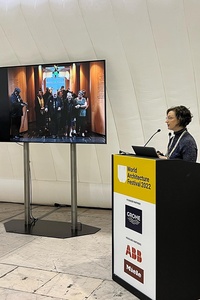
In presenting INSIDE 2022’s Public Building Award winner Te Ao Mārama at Tāmaki Paenga Hira Auckland War Memorial Museum, Jasmax project architect Marianne Riley reflected on the process of preparing for and presenting at WAF: “To frame the key design moves to an international audience, it was important for us to set out the kōrero with mana whenua and project provocations. This was a lot of ground to cover in just ten minutes. Ultimately, however, distilling the project kaupapa helped synthesize how the architecture came together. It also empowered us to represent the project and the many people involved in this ground-breaking project.”
WAF provides an opportunity for architects to present different approaches to integrating holistic indigenous worldviews into design thinking and outcomes, this is something Paul Finch sees as increasingly important and is a welcome and growing practice that is often accompanied by a similar acknowledgment of nature and natural resources.
Shortlisted in the Future Projects: Infrastructure category with Archimedia’s Te Waka Moana-Nui-a-Kiwa project, architect Lindsay Mackie relayed that:
“The (critique) process is undoubtedly a reward in itself, but once your twenty minutes are done, you know a lot of hurdles have been jumped! And there is a palpable sense of collegiality created by shared experience. It’s great to connect with people who want to talk about content and offer their own perspectives. And renewing friendships and starting new ones — WAF and especially the Gala Dinner are important for that reason alone.”
The cultural requirements of South Pacific Architecture’s Tuvalu Christian Church, shortlisted in the Religious Buildings category, held much interest for the judges and for architect Megan Rule the WAF critique experience was a rewarding opportunity to succinctly frame key concepts and values brought to the project and its community.
“I found the dialogue with an engaging jury was an incredibly valuable part of the WAF award process, it provided the opportunity to reflect on design processes that is missing from other awards.”

For architect Jeremy Smith of Irving Smith Architects — having presented and judged in festivals in Barcelona, Singapore, Berlin, Amsterdam, on the interweb, and now Lisbon — WAF is a valuable live, in-depth, and global critique. He sees it as a hybrid of the Architecture Olympics and X-Factor. “We take projects, like this year’s generatively planned 2-bedroom-for-a-family-of-five Feather House, where we want to test the discourse beyond Aotearoa. For us, that’s completed projects, but that might just be how we think of learning through doing and getting to the future. It’s certainly an international exchange.”
The composition and sensibilities of jury members add another complexity in navigating WAF success. Commenting on jury dynamics, Finch does not see any predictable differences based on geography, culture, or gender (although juries are geographically balanced). Rather, during a critique, it is the individual personalities of the jurors that emerge, and these represent diverse personal backgrounds and experiences. Such differences must be bypassed to provide informed appraisal and critique of projects that span a wide scale and spectrum, something that is evident in the moment. Jury decisions are based on proven professional experience and expertise in practice (rather than theory), which ultimately determines a final decision by consensus and impasse, as Finch reflects, is a rare occurrence:
“I have only had to ask a jury to vote formally once in 15 years when we had a 3–2 split… Over the years, we have only had a handful of cases (partly because odd-number juries usually give you a majority!) where as programme director, I have been asked to make some sort of judgement… Even then, the juries were not at each other’s throats, but had genuine differences of opinion which were understandable.”
To determine the ‘best-of-the-best’ awards on the third and final day of the festival, the ‘Super Jury’ judging process is an intense, longer affair with larger and more high profile juries with far greater ‘chalk and cheese’ aspects to consider in comparing building typologies such as church/ house/ office/ stadium/ museum/ library.
“…the festival has a real role to play in widening what is too often a cosy discourse limited to particular countries that are over-represented in the way this profession is evolving.”
-Mario Cucinella
For jurors, considerations that have arisen over time include: what is the degree of difficulty that the architect had to meet successfully?; does this project require architects (in general) to think differently about this building type?; and does the project make you think differently about architecture itself?
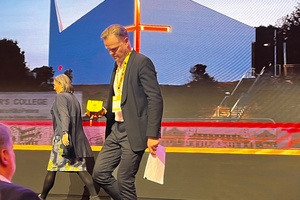
Stevens Lawson Architect’s Chapel of St. Peter was an overall winner in the Religious Buildings category, and reflecting on his Super Jury presentation on the final day, architect Gary Lawson affirms the intensity of a Super Jury presentation:
“It was intense, but as the project had already done well, I felt a sense of ‘what will be will be’. I focused on putting my best into the presentation and enjoyed it! I appreciated the Super Jury’s engaged, robust questioning… and felt it had every chance of going to the next level… I came away as a much more experienced presenter on the world stage, and with a project awarded at the highest level!”
Indeed WAF requires a reflection on practice that isn’t often present in our daily lives as architects, and it may be possible for such considerations to be translated to our local context to provide another way to engage a public audience with the architectural community for a broader dialogue. The 2022 WAF Future Project of The Year winner Iranian practice CAAT Studio is a good example of widening architectural discourse, as noted the as noted by Cucinella:
“I think for an Iranian practice to be able to share their work on an international platform in this way is incredibly valuable. This is where the festival has a real role to play in widening what is too often a cosy discourse limited to particular countries that are over-represented in the way this profession is evolving.”
Ultimately this is an awards program and festival that celebrates the skills that architects specifically offer in symphonically resolving complex societal conditions and can be viewed as a genuine and transparent peer review, best summarised by UK architect and regular WAF judge Tzswai So:
“The WAF experience is an educational exchange; participating architects are successful in being shortlisted alone, here you are being judged against the best in the world, and the international teams of judges are equally being judged by their audience in return.”

